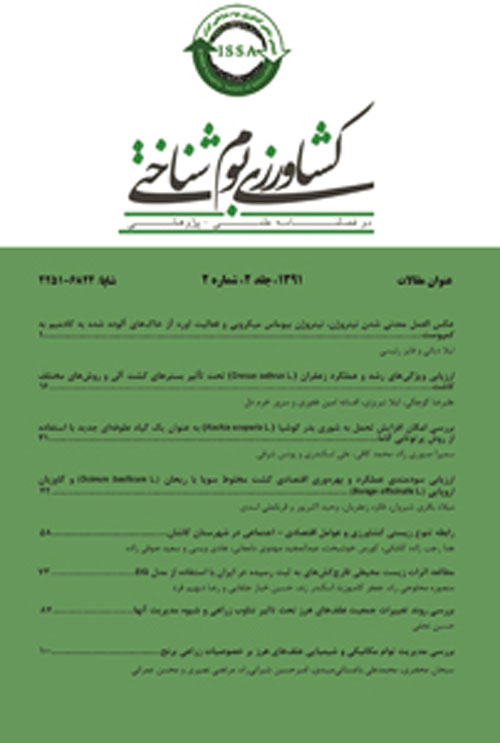Evaluation of environmental variables to identify suitable areas for corn cropping using spatial analysis of geographic information system
Author(s):
Abstract:
Introduction
One of the best ways to increase production per unit area or, in other words, ensure the optimum use of land is the identification and selection of the most appropriate land uses based on their production capacity. With regard to the high economic importance of corn and this crops role in human, livestock and poultry nutrition and its many uses in the pharmaceutical industry and in order to emphasize the importance of identifying suitable areas for the sustainable production of this crop, this study was conducted. Its objective was to identify suitable areas for corn cultivation in agricultural lands of Aliabad Katool township, GolestanPprovince using spatial analysis tools available in ArcGIS.Material and
Methods
In this study, the environmental components included: average, minimum and maximum temperatures (annual and growth season of corn); annual precipitation; and soil characteristics such as organic matter (OM), EC, depth and texture. Then, all layer overlaid and zoning of lands was carried out in four classes (highly suitable, suitable, less suitable and unsuitable) and this classification demonstrated the crop adaptation with environmental factors.Results And Discussion
Through comparison of different interpolation methods, the results showed that Kriging was the best model for identifying the distribution of precipitation and temperature in Aliabad-Katool township. Moreover, Universal Kriging (UK) was the best model based on the existence of the trend existing between climatic data due to topographic conditions. Many parts of the study area were classified as highly suitable and suitable zones according to the agro-ecological requirements of corn. The results showed that there is no temperature limitation, and all the regions were fitted to the highly suitable class. The interpolation of soil variables results demonstrated that, about 69.2 percent of agricultural land (including the northern township) and 83.5 percent of total land area, with the exception of the north-eastern regions, were classified in the highly suitable zone based on both OM and EC. The results showed that 55.58% of this region was high suitable and suitable for corn cultivation since the minimum, maximum and average temperatures and OM were suitable for this crops production in these classes. Also, the smallest (13.86%) area of unsuitable zone was located in the southern central part of this township. Etedeli and Givi (2012) indicated that environmental factors such as the average minimum temperature of growth period, sunshine during the growth stage, some land units and pH played major roles in reducing the utility of land for corn production in the Shahre Kord region. Based on the study by Yitbarek et al. (2013), Soil depth, moisture and fertility were the most important limiting factors in the physical assessment of land suitability for cotton, corn, upland rice and sorghum in Abobo region, western Ethiopia. According to these results, this region had moderately suitable conditions for the cultivation of corn. In agro-ecological zoning for canola dry-land cultivation in Lorestan Province conducted by Esteghfari (2008), the IDW method was used for mapping the environmental variables. In this research, maps of annual rainfall, mean annual temperature, mean minimum temperature, soil pH and slope were prepared and finally overlaid, then suitable areas for canola cultivation were determined for Lorestan Province.Conclusion
Finding the results of soil and climatic variables and adapting them to the agro-ecological requirements, showed that the northern regions of Aliabad Katool are highly suitable for cultivation of corn. In fact, as much as from the North to the South of the township the capacity of the land for cultivation of corn had been reduced. In this area, some unsuitable classes of texture were identified as the main limiting factor. In general, climatic factors were identified as suitable variables for corn cultivation in the agricultural lands. Keywords:
Language:
Persian
Published:
Journal of Agroecology, Volume:6 Issue: 2, 2017
Page:
200
https://www.magiran.com/p1681000


